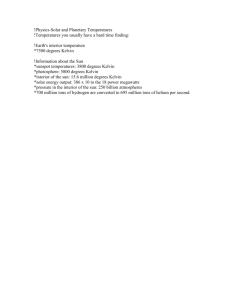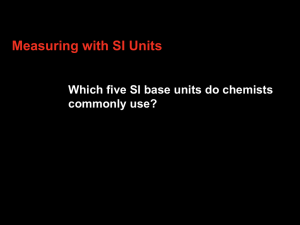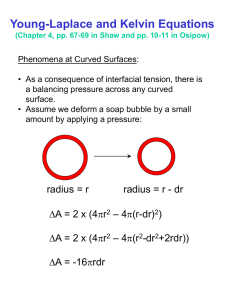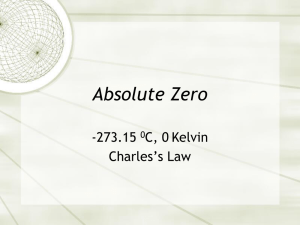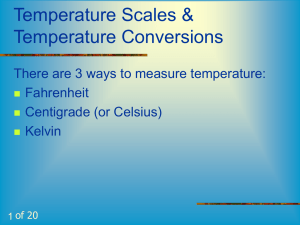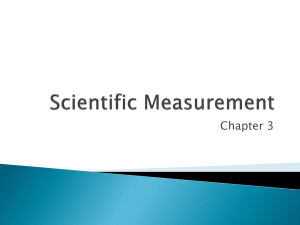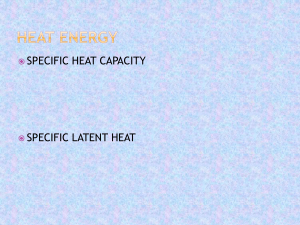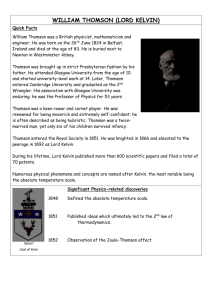Lecture 6: Gas laws
advertisement
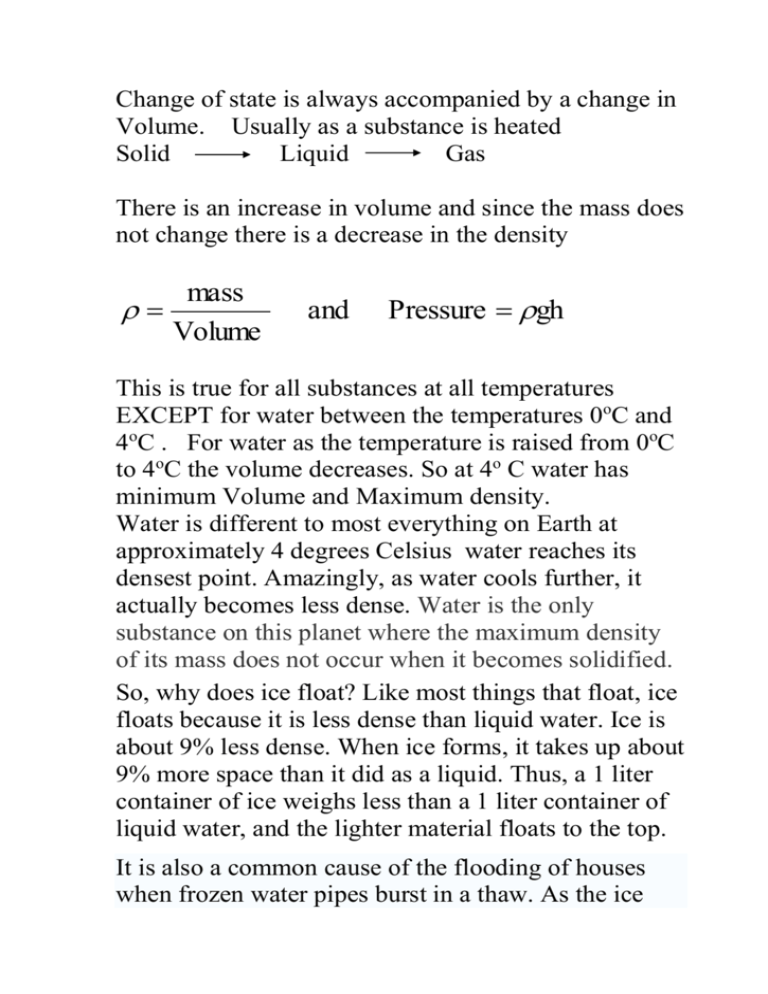
Change of state is always accompanied by a change in Volume. Usually as a substance is heated Solid Liquid Gas There is an increase in volume and since the mass does not change there is a decrease in the density mass Volume and Pressure gh This is true for all substances at all temperatures EXCEPT for water between the temperatures 0oC and 4oC . For water as the temperature is raised from 0oC to 4oC the volume decreases. So at 4o C water has minimum Volume and Maximum density. Water is different to most everything on Earth at approximately 4 degrees Celsius water reaches its densest point. Amazingly, as water cools further, it actually becomes less dense. Water is the only substance on this planet where the maximum density of its mass does not occur when it becomes solidified. So, why does ice float? Like most things that float, ice floats because it is less dense than liquid water. Ice is about 9% less dense. When ice forms, it takes up about 9% more space than it did as a liquid. Thus, a 1 liter container of ice weighs less than a 1 liter container of liquid water, and the lighter material floats to the top. It is also a common cause of the flooding of houses when frozen water pipes burst in a thaw. As the ice melts, it puts the pipe walls under substantial stress through expansion until a crack occurs at a weak point, and so relieves the imposed stress. The result of these properties is that ice floats on liquid water, which is an important factor in Earth's climate. It has been argued that natural bodies of water would freeze from the bottom up without this property resulting in the annual loss of wild life and vegetation. A plot of volume versus temperature for water between -10oC and 100oC is as follows V m3 -10 04 100 Temp oC Factors that affect the boiling point and melting point of a substance. 1. The melting point is lowered and the boiling point of a liquid is raised by the presence of and substance dissolved in the liquid e.g adding salt to water. 2. By increasing the pressure the melting point is lowered and the boiling point is raised e.g Pressure cooker GAS LAWS To study the behaviour of gases ,as regards volume temperature and pressure three experiments were carried out 1. The relationship between Volume and Pressure at constant Temperature [BOYLES LAW] 2.The relationship between Volume and Temperature at constant Pressure [CHARLES’ LAW] 3. The relationship between Pressure and Temperature at constant Volume [PRESSURE LAW] Assuming a fixed mass of gas for all the laws. Boyles Law Robert Boyle developed the law relating Volume and Pressure of a fixed mass of air at constant temperature using a glass J shaped tube having the shorter arm closed. Mercury is added to the J shaped tube until both sides are at the same level . As the longer arm is open the pressure is equal to Atmospheric Pressure which we know is equivalent to 76 cm (Hg). Also the volume of gas i.e. the air in the closed arm of the tube is measured V1 A further 76 cm (Hg) is added to the original tube which doubles the pressure. Ensuring that the temperature is kept constant the volume of gas i.e. the air in the closed arm of the tube V2 is found to be half of the original volume V1 i.e if P2 = 2 P1 Then V 2 = ½ V1 Boyle found therefore by doubling the pressure the volume of gas was halved. OR The volume of gas is INVERSELY PROPORTIONAL to the pressure exerted, at constant temperature. Volume V 1 Pressure 1 P 1 V Constant P P.V Constant at constant Temperatur e Boyles Law states that for a fixed mass of gas at constant temperature the volume is inversely proportional to the pressure. V m3 1/P CHARLES’ LAW Charles investigated the variation of volume with temperature for a fixed mass of gas at constant pressure. A plot of Volume versus temperature was plotted for temperatures in oC and was found to be as follows if the line is extrapolated back along the x axis it is found that the intercept on the x axis is -273oC so if we add +273oC to every temperature i.e change oC into Kelvin the graph becomes V(m3) O C + 273 = Temp in Kelvin A straight line through the origin Therefore at constant pressure Volume Temperatur e (Kelvin) V T @ constant Pressure V Constant at constant Pressure T Charles’ Law states that for a fixed mass of gas at constant pressure the volume is proportional to the temperature in Kelvin. PRESSURE LAW This is the study of the variation of pressure with temperature at constant volume. This time experiments were carried out where the volume is kept constant and the value for the pressure is measured as the temperature is varied. A plot of Pressure versus temperature is plotted again for temperatures above 0oC and gives Pressure ( Pa) Temp oC Again assuming that if the relationship is linear above 0o C then it is linear below 0oC and extrapolating back along the x ( temperature ) axis gives the following Pressure -273 0 Temperature Again adding +273 to all the temperature values i.e changing oC into Kelvin gives the following Pressure o C + 273 = Temp in Kelvin Therefore since the plot of Pressure versus temperature in Kelvin gives a straight line through the origin At constant volume therefore Pressure Temperatur e (Kelvin) P T @ constant Volume P Constant at constant Volume T Pressure Law states that for a fixed mass of gas at constant volume the pressure is proportional to the temperature in Kelvin. IDEAL GAS LAW This is the general equation for the behaviour of gases which incorporates all three gas laws and it states that for a fixed mass of gas Pressure by Volume divided by absolute temperature is always a constant PV Constant for a fixed mass of gas T Or It is important to remember that when using any of the gas laws the temperature value must be converted into Kelvin to be used in any of the equations. Standard Temperature and Pressure STP is used widely as a standard reference point for expression of the properties and processes of ideal gases. The standard temperature is the freezing point of water and the standard pressure is one standard atmosphere. These can be quantified as follows: Standard temperature: 0°C = 273.15 K Standard pressure = 1 atmosphere = 760 mmHg = = 101.4 x 103 Pa = 101.4 kPa Problem Sheet Gas Laws Question 1. The volume of a fixed mass of gas is 25 cm3 at a pressure of 76 cm( Hg). Calculate the volume at a pressure of 70 cm(Hg) assuming that the temperature remains constant. Given density of mercury = 13,600 kgm-3 Question 2. The volume of a fixed mass of gas is 400 cm3 at 25oC. Calculate its volume at 50oC assuming that the pressure remains constant. Question 3. The pressure on a fixed mass of gas at 15oC is 1.05 x 105 Pa. Calculate the temperature at which the pressure has decreased to 1 x 105 Pa assuming that the volume remains constant. Question 4 In the morning, when the temperature is 285 K, a bicyclist finds that the absolute pressure in his tires is 498 kPa. That afternoon he finds that the pressure in the tire has increased to 530 kPa. Ignoring expansion of the tires, find the afternoon temperature.. Question 5. At S.T.P. the volume of a fixed mass of gas is 60 cm3. Calculate its volume at a pressure of 70 cm ( Hg) and a temperature of 50oC.
